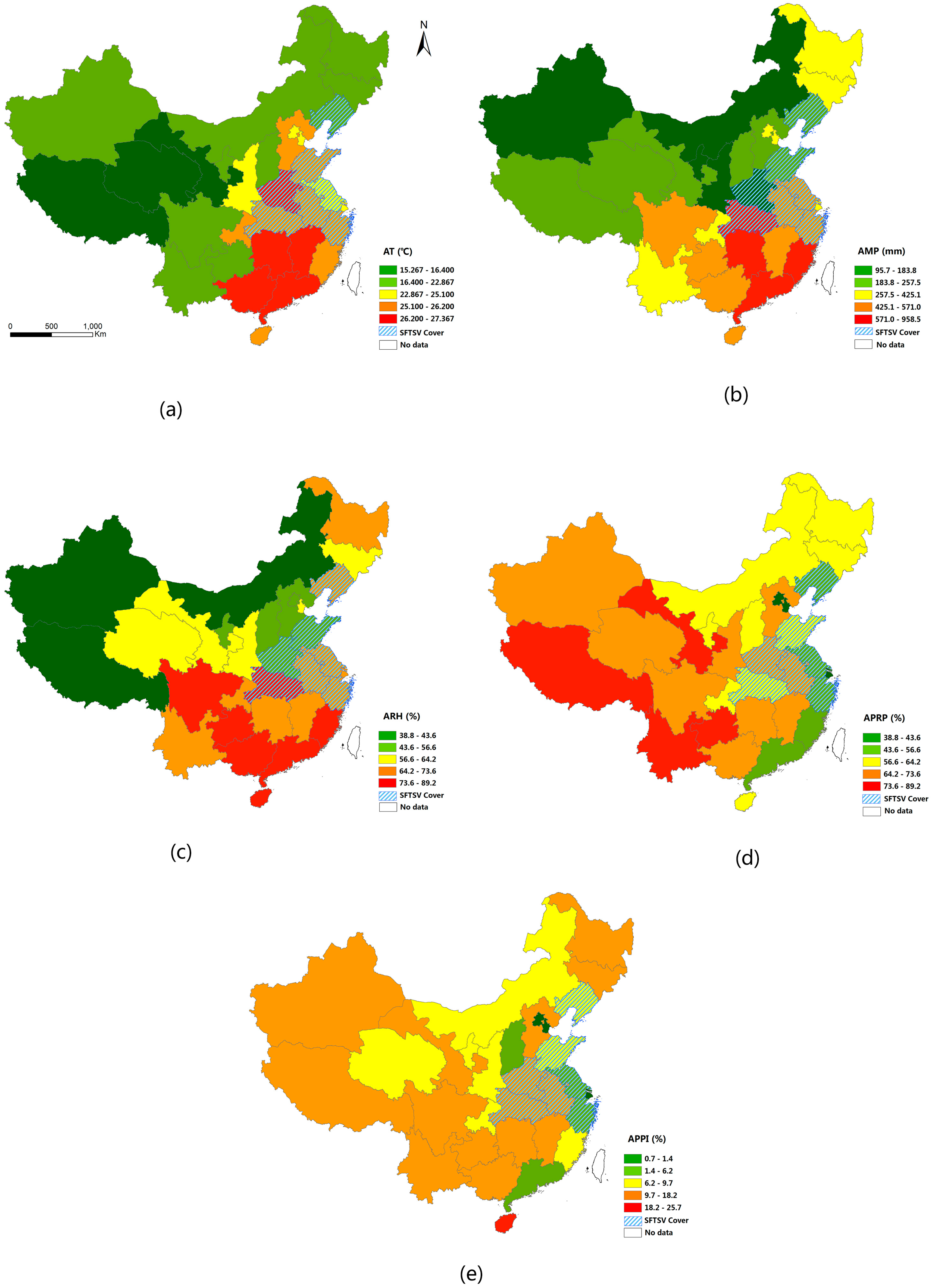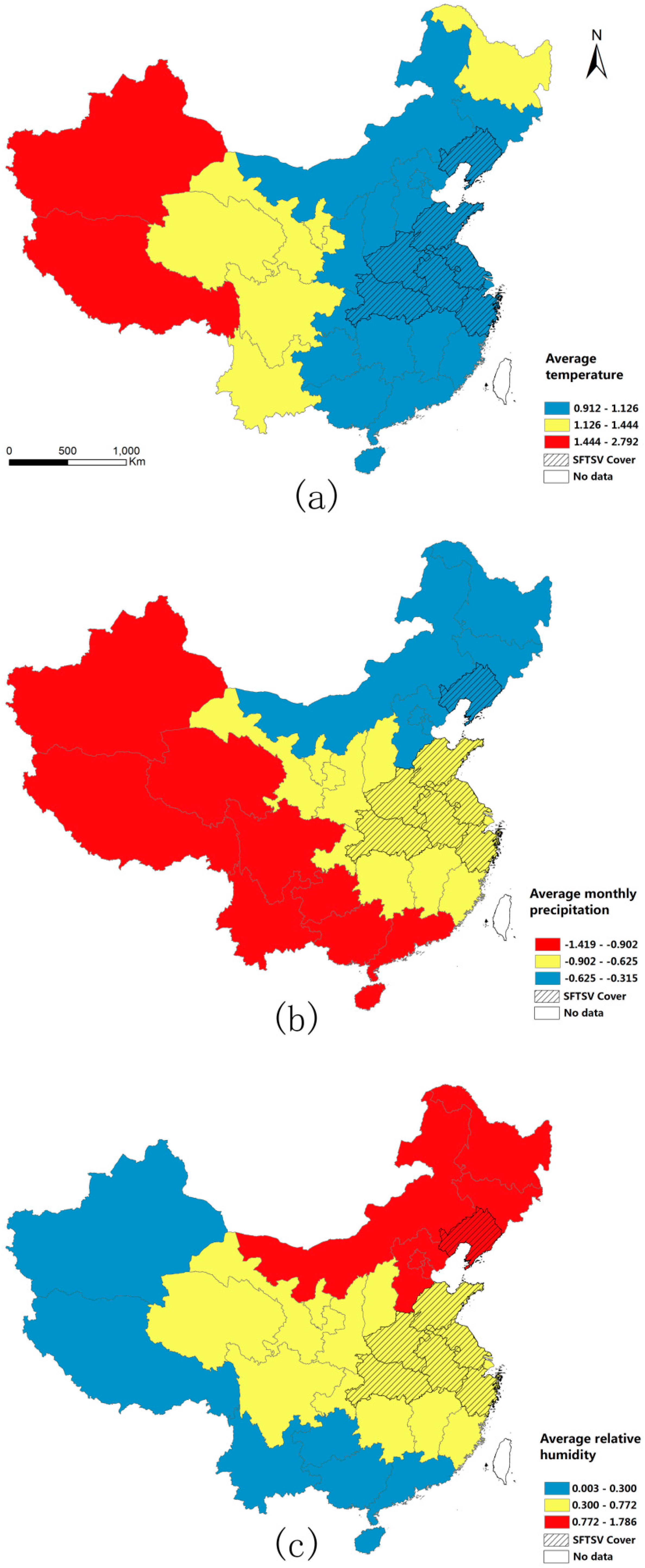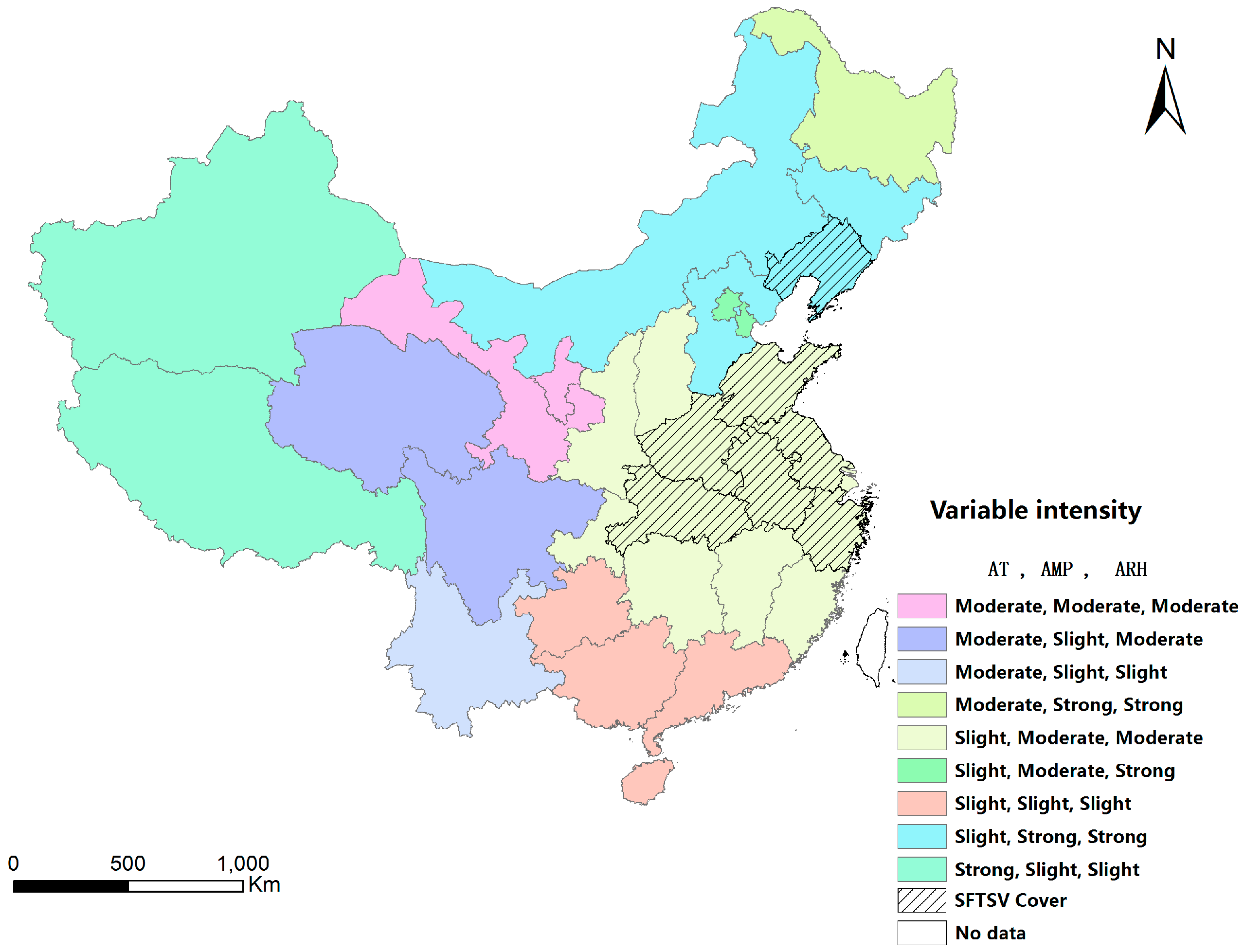1. Introduction
Severe fever with thrombocytopenia syndrome (SFTS) is an emerging infectious disease with a fatality rate of 12%. It was first reported in 2009 in the rural regions of the provinces of Hubei and Henan in central China. The clinical symptoms of SFTS are non-specific and include high fever (temperature of ≥38 °C), thrombocytopenia (platelet count of <100,000/mm
3), leukocytopenia, multi-organ dysfunction and hemorrhagic tendency [
1,
2,
3]. SFTS has been reported not only in at least 13 provinces in the central, eastern and northern regions of China [
4], but also in North Korea [
5], South Korea [
6] and Japan [
7]. SFTSV has spread wider and wider, posing an increasingly significant threat to the global health.
The majority of cases have been reported to occur in rural areas from April to July [
8]. A novel phlebovirus of the family
Bunyaviridae was identified as the causative agent of SFTS in 2010, and it was named severe fever with thrombocytopenia syndrome virus (SFTSV) or Huaiyangshan virus [
1,
9]. At the end of 2012, it was confirmed that SFTSV has been associated with SFTS in seven provinces in the central, eastern and northern regions of China, including the provinces of Hubei [
10], Henan [
11], Jiangsu [
12,
13], Liaoning [
14], Anhui [
15], Shandong [
16] and Zhejiang [
17].
The epidemiology, clinical signs and pathogenesis of SFTS have been widely studied [
18,
19,
20,
21,
22], and over 200 individual nucleotide sequences of SFTSV have been submitted to GenBank. However, the transmission of SFTSV remains an important and yet unexplained process. A previous study suggested that SFTSV is an arbovirus that can be transmitted by
Haemaphysalis longicornis, a species of tick [
1]. Humans can become infected through tick bites or by contact with infected blood or bloody secretions from humans or livestock [
23,
24]. Moreover, many studies showed that tick-borne diseases like Lyme disease, rickettsiosis and tick-borne encephalitis have a strong association with environmental factors [
25,
26,
27]. Considering that the majority of patients of confirmed SFTS cases lived in rural areas and were employed in agriculture [
8,
18], we hypothesize SFTS might be influenced by environmental factors and anthropogenic factors. Our study has two major objectives: (1) to identify the factors of SFTSV based on data from seven provinces with SFTSV cover and other provinces that had no reported cases; (2) to predict high-risk areas in China.
SFTSV cover means positive provinces or confirmed areas. The provinces experienced cases of SFTS that tested positive for SFTSV in patients were defined as SFTSV cover or confirmed areas of SFTSV. Furthermore, it might be difficult to distinguish SFTSV cover from reported SFTSV. Some provinces have even reported some cases with symptoms similar to SFTS, but the medics were unable to extract the SFTS virus from the patients. Therefore, these provinces were defined as SFTSV reported but not so-called SFTSV cover.
In this study, we estimated a geographically weighted logistic regression (GWLR) model and explore the spatial associations of SFTSV with the following potential determinants: meteorological factors (average temperature (AT), average monthly precipitation (AMP) and average relative humidity (ARH)), the average proportion of rural population (APRP) and the average proportion of primary industries (APPI).
4. Discussion
This study found that meteorological factors (temperature, precipitation and relative humidity) were associated with SFTSV cover and that the influence of meteorological factors on SFTSV cover varies in different areas.
Numerous previous studies have explored the potential factors that influence the incidence of SFTS in various regions. One such study used a Poisson regression analysis to show that the spatial variations in the incidence of SFTS were significantly associated with shrub, forest and rain-fed cropland areas in the Xinyang region of the Henan province in China [
18]. Another study conducted spatial scan statistics and multivariate model of SFTS in China using the surveillance data from 2010 to 2013, and they detected three hot spots of SFTS in China and identified independent risk factors of the distribution of SFTS [
50]. Additional studies have assessed the potential factors that influence the incidence of other infectious but not vector-borne diseases, and these studies have used a variety of different methodologies. A relationship between climatic factors and local transmission was found for the 2009 pandemic influenza A virus (H1N1) in mainland China in a study that used a multilevel Poisson regression model [
51]. Another study developed a logistic regression model to assess the relationships between known populations of
Ixodes scapularis (a tick that is the main vector for Lyme disease in the USA) and environmental factors (the minimum, maximum and mean monthly temperature and vapor pressure) in order to investigate Lyme disease in the USA [
25]. A third study used GWR models to explore the association of the incidence of hand, foot and mouth disease (HFMD) with child population density and climatic factors at the county level in China [
52], and the authors found that child population density had a stronger influence than climatic factors on the incidence of HFMD.
In these previous studies, statistical methodologies were used to explore the factors that are associated with various infectious diseases, including climatic factors. However, they used different types of models (e.g., an OLS model, a Poisson regression model and a GWR model). An OLS model was not included in our study since SFTSV cover is binomial variable. Insignificant results would be gained if we joined binomial variable into OLS model. Another global regression model, LR model, was utilized for comparison analysis. A previous study compared a GWLR model with an orthodox LR model of the spatial variations of urban growth patterns in the Chinese city of Nanjing [
35] showed that the GWLR model significantly improves on the global LR model in terms of goodness-of-fit. In the present study, we firstly estimated each GWLR model, and compared their performance with that of corresponding LR models. To be specific, three non-spatial LR models were constructed and compared with three GWLR models. The three LR models were consistent with the respective GWLR models, and the LR models had the same explanatory variables as those in the GWLR models. Our results support a growing body of recent literature [
38,
53,
54] underlining the superiority of spatially explicit regression models relative to orthodox global models.
Our study underlined the fact that the effect sizes of each explanatory variable in each province are potentially heterogeneous and utilized a GWLR model which is a sort of spatially explicit regression model. Additionally, this study explored both meteorological and anthropogenic factors and found that meteorological factors were associated with SFTSV cover by using GWLR models. Compared with traditional regression analysis, spatially explicit models could cover local variations and indicate spatial heterogeneity, thus underlining the notion that specific places within the same study area might differ from each other with regard to the nature and extent of meteorological injustice.
GWLR indicated that many of the observed statistical associations between SFTSV risk and specific explanatory variables are not uniform across China. More specifically, the local estimates of parameters of variables enabled us to investigate variations in the influences of the explanatory variables on SFTSV cover. From the maps of the estimated coefficients, the differences between locations regarding the strength of the associations between the explanatory variables and the probability of SFTSV cover were clear. Regarding temperature, the strength of the association decreased from east to west across China, and there was only a slight association in large areas of the mainland. Additionally, the estimated coefficients for relative humidity increased from southwest to northeast across China. The pattern for precipitation was similar to that for relative humidity; however, the coefficients increased in the opposite direction across China.
Based on our findings, we speculate that the high-risk areas are yellow areas in
Figure 6, with slight temperature influence (25.5–27 °C) and moderate precipitation (442.4–644.8 mm) and moderate relative humidity (72%–80%). To be more specific in location, the areas where SFTSV has been isolated, and the provinces of Shanxi, Shaanxi, Guizhou, Hunan, Jiangxi, Fujian and Shanghai which surround the former, should be carefully monitored. Furthermore, there are several improvements that could be made to this analysis in the future. Firstly, although SFTS is a tick-borne disease, tick density was not included in the models because of the lack of data on the vector populations. We attempted to acquire data on tick density in China, but this information proved difficult to obtain. However, the model could be further improved if tick density was taken into account.
In addition, the sample size used in the analysis was small. As SFTS is a new epidemic disease, we could not obtain data on SFTS at a more granular level than province-level data. In this analysis, SFTSV data from 2010 to 2012 were obtained from the NCBI database, and province data were often included but more precise location data were rarely included. Although we only obtained approximate location data, strong factors that are associated with SFTSV cover between SFTSV and meteorological factors was found. Despite this, we recognize that this analysis is only a preliminary analysis of spatial associations and it has its limitations. The results of our study highlight the need for researchers to recognize the usefulness of GWLR as an exploratory data analysis tool for SFTSV risk assessment. More local-level research is necessary, however, to determine why statistical relationships between SFTSV cover and specific explanatory factors vary in certain parts of China. Meanwhile, we appeal to researchers to provide more precise location data when they upload SFTSV data to the NCBI database in order to aid scientific progress.
5. Conclusions
The study showed that a GWLR model is appropriate to assess the SFTSV cover in mainland China. Meteorological factors (temperature, precipitation and relative humidity) are associated with the SFTSV cover, and the influence of these meteorological factors on the SFTSV cover varies across different areas. Meanwhile, the provinces of Shanxi, Shaanxi, Guizhou, Hunan, Jiangxi, Fujian and Shanghai should be carefully monitored, as they surround the areas where SFTSV has been isolated and they have suitable conditions for SFTSV transmission compared with the other provinces where SFTSV has not yet been isolated.
There is currently no vaccine for SFTSV and SFTS often has fatal consequences. Our findings provide evidence to support public health policy and decision-making in allocating resources locally, which will enable better identification and detection of high risk areas, a reduction of the risk of infection and strengthened population resilience. We suggest that the efforts put into control strategies and prevention should be greater in areas where environmental factors are known to pose a significant risk. For instance, medical professionals could give extra attention to suspicious cases in high-risk areas and verify whether these cases involve SFTSV infections. Additionally, in these cases, attempts should be made to isolate the virus and to confirm the diagnosis. Further accumulation of data on cases of SFTSV infection will aid in the control of SFTSV and the prevention of SFTS.













